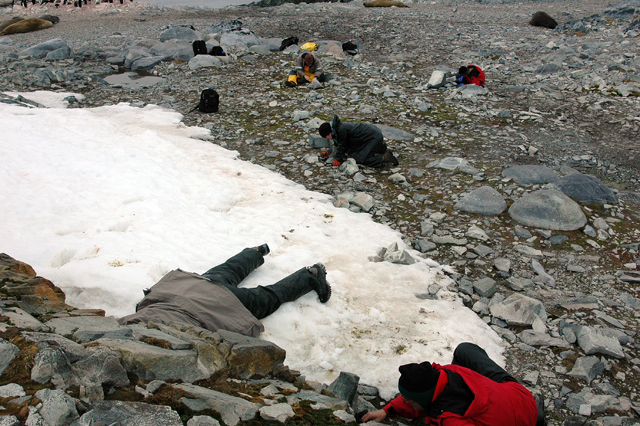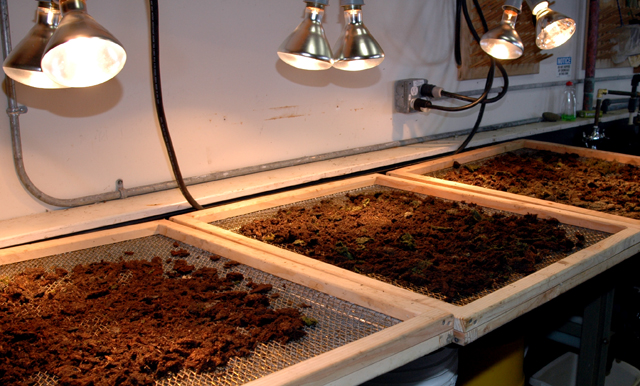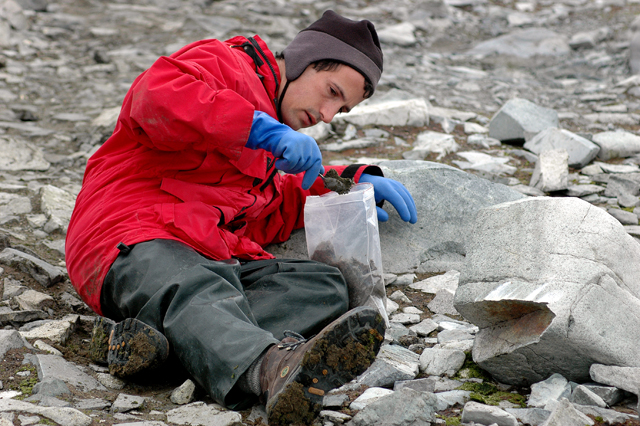Page 2/3 - Posted January 29, 2010
Debugging BelgicaBelgica is a member of the order Diptera, which includes mosquitoes and flies. They are found only on the Antarctic Peninsula and in a variety of diverse microhabitats, from the small clumps of Prasiola and grasses found on the rocky islands to the well-fertilized mud near penguin rookeries and elephant seal wallows. Belgica enjoys such a wide range of habitats, filling every conceivable niche, by virtue of its lone terrestrial supremacy. “There are no other competitors down here, nothing even closely related,” Lee says. “They have no predators, no parasites that we know of.” The midges have a two-year life cycle. They spend most of it as worm-like larvae, up to 6 millimeters long, eating all the bacteria, detritus and algae they can. They molt into adults in the summer, enjoying a brief flowering, two weeks at most, to mate and lay eggs. The eggs, looking like tiny dried tomato seeds, hatch after a week and the new larvae begin feeding. The team’s arrival in the first year of its new grant timed remarkably well with the emergence of the adults. The scientists have never encountered this kind of abundance before. “The party will be over pretty soon for them,” says Denlinger, who, like Lee and probably most entomologists, enjoyed a childhood fascination for insects. “Most people I know outgrow that at some point; some of us don’t.” The team’s research has shown that midges can tolerate the loss of up to 70 percent of their body water. But its major finding from the first grant period between 2005 and 2007 was that Belgica could keep feeding and growing despite the fact that it is in cellular survival mode 24/7. Its heat shock proteins — proteins whose “expression” increases when cells are exposed to elevated temperatures or other stress — are working all the time. [See previous article from Nov. 26, 2006 “That’s absolutely not the dogma everywhere else in the world,” Lee says while making a final walk around the northeastern half of Torgersen. “When you turn on those proteins, you stop making everything else. You’re in a survival mode … Down here they’re obviously growing and feeding. At the same time, they’re producing high levels of heat-shock proteins.” Denlinger adds, “We think having those heat shock proteins on all the time is probably a very important thing for them to survive in these types of environments.” Weathering the winterNow Lee and Denlinger are back after about a two-year hiatus with two graduate students and a former member of Lee’s lab with a new grant to collect new specimens to answer a new set of questions. Foremost among the fresh mysteries for the entomologists is learning more about how Belgica spends the winter in Antarctica. Its freeze tolerance is at work year-round, but possibly enhanced in the colder, dark winter months. Freeze tolerance in another Antarctic arthropod, Cryptopygus antarcticus, involves cryoprotective dehydration. The tiny springtail, which jumps around like a flea but is not a true insect, gradually loses water and dries out, lowering its freezing point. In the lab, Belgica demonstrates a similar ability. “That’s never been shown before in a true insect,” Lee notes. The lab is one thing; but does it happen in nature? Perhaps it varies by the microhabitat, he suggests, so that in wetter areas the polar midge simply freezes while in drier patches it cryoprotectively dehydrates. In a future field season, he says, someone from the team will return to the islands after the summer season, perhaps as late as May, to learn more about that process. The finch effectAnother goal is to determine just how genetically homogenous Belgica is among the different islands it inhabits. Being wingless, its ability to disperse geographically is pretty limited but not impossible. The wind could help spread it across the closely spaced islands. And they can float on the water as well as a lifejacket. But it’s more likely that Belgica is a homebody, having probably lived in Antarctica for millions of years, fragmented geographically. The scientists want to know if the relative isolation between islands produces significant genetic differences among the populations. “It’s sort of like what Darwin saw with his finches, where you have little populations on different islands that are in some ways evolving into different species. We’re going to look for evidence of that occurring in Belgica,” explains Nick Teets, a PhD student who works with Denlinger. “We’re trying to get populations from as [distant] islands as we can to see if there might be some incipient speciation going on,” Denlinger adds, saying that the team hopes to sequence the Belgica genome in the next year or so to target their research on specific genes involved in over-wintering adaptations.Back 1 2 3 Next |



For USAP Participants |
For The Public |
For Researchers and EducatorsContact UsNational Science FoundationOffice of Polar Programs Geosciences Directorate 2415 Eisenhower Avenue, Suite W7100 Alexandria, VA 22314 Sign up for the NSF Office of Polar Programs newsletter and events. Feedback Form |





